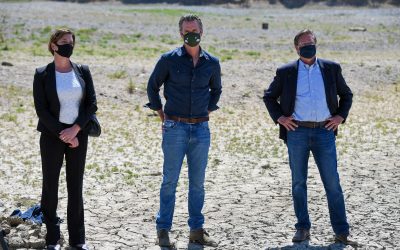Sacramento, CA…Governor Gavin Newsom today significantly expanded his April 21 drought emergency proclamation to include Klamath River, Sacramento-San Joaquin Delta and Tulare Lake Watershed counties where accelerated action is needed to protect public health, safety and the environment. In total, 41 counties are now under a drought state of emergency, representing 30 percent of the state’s population.

Climate change-induced early warm temperatures and extremely dry soils have further depleted the expected runoff water from the Sierra-Cascade snowpack, resulting in historic and unanticipated reductions in the amount of water flowing to major reservoirs, especially in Klamath River, Sacramento-San Joaquin Delta and Tulare Lake Watershed counties.
“With the reality of climate change abundantly clear in California, we’re taking urgent action to address acute water supply shortfalls in northern and central California while also building our water resilience to safeguard communities in the decades ahead,” said Governor Newsom. “We’re working with local officials and other partners to protect public health and safety and the environment, and call on all Californians to help meet this challenge by stepping up their efforts to save water.”
In April, Governor Newsom signed an emergency proclamation directing state agencies to take immediate action to bolster drought resilience across the state and declaring a State of Emergency in Mendocino and Sonoma counties due to severe drought conditions in the Russian River Watershed. Today, the Governor took action to ensure an expedited response to address acute drought impacts in Klamath River, Sacramento-San Joaquin Delta and Tulare Lake Watershed counties.
Today’s drought emergency proclamation adds the following 39 counties: Del Norte, Humboldt, Siskiyou, Trinity, Alameda, Alpine, Amador, Butte, Calaveras, Colusa, Contra Costa, El Dorado, Fresno, Glenn, Kern, Kings, Lake, Lassen, Madera, Mariposa, Merced, Modoc, Napa, Nevada, Placer, Plumas, Sacramento, San Benito, San Joaquin, Shasta, Sierra, Solano, Stanislaus, Sutter, Tehama, Tulare, Tuolumne, Yolo and Yuba counties. Additionally, the proclamation provides new authority for the existing drought emergency announced on April 21 for Mendocino and Sonoma counties.
Extraordinarily warm temperatures in April and early May separate this critically dry year from all others on California record. California experienced an accelerated rate of snow melt in the Sacramento, Feather and American River watersheds, which feed the major reservoirs of the state and federal water projects. This was exacerbated when much of the snowpack, sitting on very dry ground, seeped into the earth rather than flowing into our rivers and streams and into these reservoirs. Warming temperatures also prompted water diverters below the dams to withdraw their water much earlier and in greater volumes than typical even in other recent critically dry years. These factors reduced expected water supplies by more than 500,000 acre feet, enough to supply up to one million households with water for a year. The drastic reduction in water supplies means these reservoirs are extremely low for water users, including farmers, and fish and wildlife in the counties the drought proclamation covers.
The Governor’s proclamation directs the State Water Board to consider modifying requirements for reservoir releases and diversion limitations to conserve water upstream later in the year to maintain water supply, improve water quality and protect cold water pools for salmon and steelhead. The state of emergency also enables flexibilities in regulatory requirements and procurement processes to mitigate drought impacts and directs state water officials to expedite the review and processing of voluntary transfers of water from one water right holder to another, enabling available water to flow where it is needed most.
The text of today’s emergency proclamation can be found here.
The Governor’s executive action last month directed state agencies to partner with local water suppliers to promote conservation through the Save Our Water campaign, a critical resources for Californians during the 2012-2016 drought. Some municipalities have already adopted mandatory local water-saving requirements, and many more have called for voluntary water use reductions.
“It’s time for Californians to pull together once again to save water,” said California Natural Resources Agency Secretary Wade Crowfoot. “All of us need to find every opportunity to save water where we can: limit outdoor watering, take shorter showers, turn off the water while brushing your teeth or washing dishes. Homeowners, municipalities, and water diverters can help by addressing leaks and other types of water loss, which can account for over 30 percent of water use in some areas.”
Actions by the Administration to address drought to date include:
- Identifying water suppliers at extreme financial risk that may need additional support due to the combined impacts of COVID and drought.
- Updating the Department of Water Resources’ Dry Well website, which tracks voluntarily reported supply issues by counties.
- Streamlining water transfer processes.
- Issuing letters from the State Water Resources Control Board to water right holders, urging them to plan for potential shortages by reducing water use and adopting practical conservation measures.
- Completing the state’s first drinking water needs assessment in which the State Water Board identified small water systems and domestic wells that are failing or at risk of failing to meet the state’s drinking water standards. By working toward solutions with these systems, we are improving their drought resiliency.
For more tips on saving water, visit www.saveourwater.com.
Learn more about current conditions, the state’s response and informational resources available to the public at the state’s new drought preparedness website.
###



Pingback: Governor Newsom Expands Drought Emergency to 41 Counties Including, Alpine, Amad… – Water News Hub